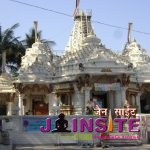SHRI KHAJURAHO TIRTH



PRESIDING DEITY AND LOCATION :
Shri Shanthinath Bhagwan, in red color, in a standing posture, of height 4.27 meters in a shrine, 1 Km away from Khajuraho in the east on the banks of river Khudar. (Dig).
ANTIQUITY AND SALIENT FEATURES :
The Jain temples of Khajuraho were built during the reign of Chandel Kings from Vikram 9th to 12th centuries. The gorgeous and enchanting temple of Sri Parshvanath Bhagwan was built by Jain Shreshthis Sri Pahil who was honored by the royal court of Chandel King Sri Dhang during the period between Vikram year 950 and 1002. There is an inscription found on the temple gate which states that the temple was built in Vikram year 1011 during the reign of Maharaja Dhang and for maintenance prayers and worship according to rites and rituals Sri Pahil had gifted seven farms (Vatikas). And also on the back of the Presiding Deity in the temple is Sri Shanthinath Bhagwan, there is an inscription dated Vikram year 1084.
Khajuraho is famous throughout the world for its art and sculpture. Artistic images carved in stone with intricacy found here are one of its kinds.
In the sprawling walled area of 103000 sq. feet i.e. 412’ X 250’, there is a total of 34 temples of which 22 are with Sikhars. In the west of this cluster, there are relics of ancient Jain temples known as Ghotai Mandir. Besides these, there is a Shanthinath Museum in which a great number of beautiful art pieces have been carefully collected and preserved.
Here among Jain temples, those of Sri Parshvanath, Sri Adinath and Sri Shanthinath Bhagwan are known all over the world for their expanse, beauty and incomparable art. Sri Parshvanath temple with its hundreds of small and large Sikhar is most captivating because of the perfect co-ordination involved and executed. Two images of Arhats are carved in the central part of the principal arch of the entry gate and on both sides thereof six saints each are shown praying. On the doors of inner sanctum, goddesses Gangam Yamuna, Chakeshvari, Saraswati and nine planet Gods are vividly crafted. In the circular trajectory of the temple sanctum, damsels, fairies, nymphs and goddesses are carved with intermittent idols of Tirthankars. Keeping images of Tirthankars in the centre, a “Kuber” couple (Kuber is the Lord of Wealth),a guardian deity as keeper of all the ten directions and various other gods as Guardians of Jain order riding elephants are carved voluptuous figures of a damsel decorating herself with ornaments, a woman applying fragrant paste at the bottom of her feet, a lovely lady applying collyrium in her eyes, a dancer getting ready for her performance by tying anklets, God of love with five arrows in his hands, a “Vidyasagar” couple ( a God proficient in all arts ) standing with a garland of flowers, and musicians playing small and large instruments. In the words of famous archeologist and master connoisseur of art Mr. Fergusson it can be stated that the whole temple has been erected so proficiently that nowhere its second can be found in the fields of architectural style and creative beauty. The shape of the temple with its perfect coordination of domes and carvings, both intricate and delicate, is just incomparable.
The temple of Sri Adinath Bhagwan is well known for the simplicity of its tall sikhar, the magnificence of its top-pot specially shaped, and the grandeur of its “Suchichakra, Amlak and Kumbhkalash” (distinctive temple decorations).On both sides of the entry gate Ganga, Yamuna and the gate keeper god are carved. On the outside walls are crafted rows of images of Gansharvas, Kinnars and Vidyadhars (typical Gods of different amorous arts) and in remaining two rows Guardian Deities of the Jain order (Shashan Devata) and nymphs are vividly shown. At the order is a beautiful and marvelous figure of Gomukh, servant god of Jain order associated with Sri Adinath Bhagwan. Other creations such as the one of a beauty conscious lovely female applying “Sindhur” (red powder) at the parting of her hair-do and looking into the mirror, the other equally attractive and pretty woman applying “Kajal” (Collurium) in her eyes also looking into the mirror, the one of an anxiety-laden damsel on reading the letter containing sorrowful news, and the one of a mother showering her affection on the child etc. are remarkably alive and impressive.
APPROACH – ROUTE :
Among the railway station nearby the shrine are Harpalpur, Mahoba on Jhansi – Manekpur rail line of central railway and (2) Satna on Howrah – Mumbai rail line. At all these stations, direct buses are also available for Khajuraho from Jhansi, Bhopal, Satna and Sagar. The flight going from Delhi to Khajuraho goes via Agra and Khajuraho. Also the flight going to Varanasi always goes via Khajuraho. This shrine is 55 Kms in the south of Mahoba, 43 Kms in the west of Panna and 46 Kms in the east of Chhattarpur, Satna is 120 Kms, shrine of Drongiri is 100 Kms and that of Reshandigiri is 165 Kms away from here.
AMENITIES FOR JAIN PILGRIMS :
There is a dharamshala near the temple within the walled enclosure with all facilities and a bhojanshala too.
MANAGED BY :
Shri Digamber Jain Atishaykshetra Khajuraho ,
P.O. Khajuraho – 471 606.
Dist : Chhattarpur , Madhya Pradesh
Tel: 07686 – 74148.






